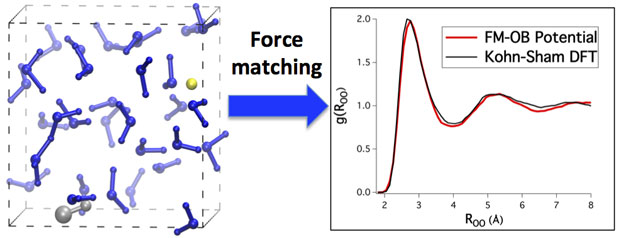Nir Goldman (16-LW-020)
Project Description
One theory of how life came to Earth is that cometary impact may have triggered planetary prebiotic chemistry. Comets and astrophysical ices are heterogeneous materials predominantly composed of water, with significant concentrations of both oxidized and reduced forms of carbon. We plan to focus on the formation of polymeric prebiotic material under conditions of extreme pressures and temperatures such as those resulting from impacting comets and other icy extraterrestrial bodies. Hydrogen cyanide, prevalent in astrophysical ices, can polymerize in aqueous solution, forming large molecules, including the nucleotides that are subunits for deoxyribonucleic acid and protein-forming polypeptides (chains of linked amino acids). However, the fate of hydrogen cyanide during an impact event is entirely unknown. To investigate, we intend to develop novel molecular dynamics tools to conduct simulations of the prebiotic self-assembly of hydrogen cyanide into complex biomaterials under extreme conditions. Our general approach will efficiently determine simple computational models for reactive systems by taking each thermodynamic state of interest and iteratively comparing it to high-level quantum calculations based on density functional theory (routinely used to investigate the electronic structure of many-body systems). This self-adaptive, force-matching method differs from most current approaches, which attempt to create a single force field that has universal applicability to all systems and conditions of interest. Using this approach, we will be able to create molecular dynamic models that will bridge the time and length gap with experiments while retaining most of the accuracy of quantum simulations (see figure). In doing so, we will create a chemical road map for the possible reaction mechanisms and products that could be produced during high pressure–temperature astrobiology experiments. Knowledge of these properties will help create a bottom-up understanding for hydrocarbon impact synthesis on early Earth and its role in producing life-building molecules.
The data we will produce will help create a fundamental picture of the production of primary biomaterials from exogenous icy materials that likely bombarded early Earth. This will give us the unique opportunity to help answer long-standing questions regarding the synthesis of biopolymers from these impact events. Our efforts will help determine the self-assembly of carbon into life-building materials that could have been formed during impact events and will address key needs for experiments in astrobiology and studies of the origins of life. Our results will help narrow the thermodynamic conditions that need to be explored and will provide guidance for relevant chemical products that could be formed in future experiments. As result of this project, we will have also developed a computational framework for accelerating quantum calculations by several orders of magnitude, allowing for direct simulation of many types of experiments under extreme conditions. This simulation method, which will use quantum codes to compute forces at every step, will circumvent the critical timescale and length-scale limitations of standard quantum codes while retaining most of their accuracy. Such a method could prove valuable to studies in other areas, such as in shocked explosives, polymers, and composites.
Mission Relevance
Creating computationally efficient tools that are broadly applicable to shocked systems and materials directly supports the Laboratory's stockpile stewardship science strategic focus area. The project's focus on the simulation of the behavior and performance of complex systems, such as the development of biomaterials under extreme conditions and development of new simulation tools, also aligns with the core competency of high-performance computing, simulation, and data science.
FY16 Accomplishments and Results
In FY16 we (1) began density-functional-theory simulations of reactive aqueous solutions at extreme conditions, (2) determined the optimal basis set and system sizes for optimal calculation parameters, (3) used the results from our quantum simulations in iterative force-matching calculations for these systems, and (4) determined optimal functional forms of the two- and three-body interactions, as well as the use of damping and scaling parameters to improve the quality of our potential.
Publications and Presentations
- Goldman, N., “Using force-matched potentials to improve the accuracy of density functional tight binding for reactive conditions.” J. Chem. Theory Comput. 11, 4530 (2015). LLNL-JRNL-675158. http://dx.doi.org/10.1021/acs.jctc.5b00742






